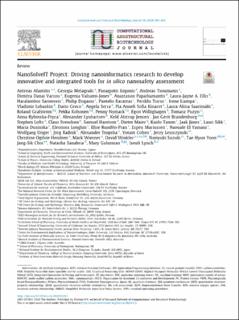NanoSolveIT Project: Driving nanoinformatics research to develop innovative and integrated tools for in silico nanosafety assessment
Afantitis, Antreas; Melagraki, Georgia; Isigonis, Panagiotis; Tsoumanis, Andreas; Varsou, Dimitra Danai; Valsami-Jones, Eugenia; Papadiamantis, Anastasios; Ellis, Laura-Jayne; Sarimveis, Haralambos; Doganis, Philip; Karatzas, Pantelis; Tsiros, Periklis; Liampa, Irene; Lobaskin, Vladimir; Greco, Dario; Serra, Angela; Kinaret, Pia Anneli Sofia; Saarimaki, Laura Aliisa; Grafström, Roland; Kohonen, Pekka; Nymark, Penny; Willighagen, Egon; Puzyn, Tomasz; Rybinska-Fryca, Anna; Lyubartsev, Alexander; Jensen, Keld Alstrup; Brandenburg, Gerit; Lofts, Stephen; Svendsen, Claus; Harrison, Samuel; Maier, Dieter; Tamm, Kaido; Janes, Jaak; Sikk, Lauri; Dusinska, Maria; Longhin, Eleonora Marte; Rundén-Pran, Elise; Mariussen, Espen; El Yamani, Naouale; Unger, Wolfgang; Radnik, Jörg; Tropsha, Alexander; Cohen, Yoram; Leszcynski, Jerzy; Hendren, Christine Ogilvie; Wiesner, Mark; Winkler, David; Suzuki, Noriyuki; Yoon, Tae Hyun; Choi, Jang-Sik; Gulumian, Mary; Lynch, Iseult
Peer reviewed, Journal article
Published version
Permanent lenke
https://hdl.handle.net/11250/2650566Utgivelsesdato
2020Metadata
Vis full innførselSamlinger
- Publikasjoner fra Cristin - NILU [1360]
- Vitenskapelige publikasjoner [1096]
Originalversjon
Computational and Structural Biotechnology Journal. 2020, 18 583-602. 10.1016/j.csbj.2020.02.023Sammendrag
Nanotechnology has enabled the discovery of a multitude of novel materials exhibiting unique physicochemical (PChem) properties compared to their bulk analogues. These properties have led to a rapidly increasing range of commercial applications; this, however, may come at a cost, if an association to long-term health and environmental risks is discovered or even just perceived. Many nanomaterials (NMs) have not yet had their potential adverse biological effects fully assessed, due to costs and time constraints associated with the experimental assessment, frequently involving animals. Here, the available NM libraries are analyzed for their suitability for integration with novel nanoinformatics approaches and for the development of NM specific Integrated Approaches to Testing and Assessment (IATA) for human and environmental risk assessment, all within the NanoSolveIT cloud-platform. These established and well-characterized NM libraries (e.g. NanoMILE, NanoSolutions, NANoREG, NanoFASE, caLIBRAte, NanoTEST and the Nanomaterial Registry (>2000 NMs)) contain physicochemical characterization data as well as data for several relevant biological endpoints, assessed in part using harmonized Organisation for Economic Co-operation and Development (OECD) methods and test guidelines. Integration of such extensive NM information sources with the latest nanoinformatics methods will allow NanoSolveIT to model the relationships between NM structure (morphology), properties and their adverse effects and to predict the effects of other NMs for which less data is available. The project specifically addresses the needs of regulatory agencies and industry to effectively and rapidly evaluate the exposure, NM hazard and risk from nanomaterials and nano-enabled products, enabling implementation of computational ‘safe-by-design’ approaches to facilitate NM commercialization.

